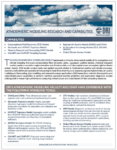Atmospheric Modeling Group
About Atmospheric Modeling at DRI
The DRI Atmospheric Modeling Group implements a full suite of numerical models of the atmosphere and climate including fine-scale computational fluid dynamics codes, Lagrangian particle models, chemical transport models, medium-resolution regional weather and climate models, and fully coupled ocean-atmospheric global climate system models.
DRI Division of Atmospheric Sciences faculty conduct basic and applied research related to fundamental weather and climate processes, weather predictability and operational forecasting for lead-times from hours to seasonal, regional hydroclimate, air-quality modeling and forecasting, dust modeling, and renewable energy applications.
DRI researchers maintain the expertise and cyberinfrastructure capabilities to perform real-time numerical weather prediction and exploratory diagnostic studies utilizing both in-house high-performance computing infrastructure and cloud-based off-site computing resources.
Our Capabilities
- Computational Fluid Dynamics (CFD) Models
- Stochastic and HYSPLIT Trajectory Models
- Weather Research and Forecasting (WRF) Model
- CALMET and CALPUFF Modeling System
- Regional Air Quality Models (CMAQ and CAMx)
- Air Emissions Processing Models (BEIS, MEGAN, SMOKE)
- Global Climate System Models
CFD Models
High-resolution simulations of turbulent flows for fine-scale analyses. The openFOAM framework allows for traditional aerodynamics applications and the coupling of additional physics, such as multiphase flows, porous objects, and particle transport.
CALMET and CALPUFF
Diagnostic meteorology and dispersion models for short- and long-range transport assessments.
WRF Model
Diagnostic and forecast model to develop meteorological solutions from sub-kilometer to regional scales, from case studies to intra-seasonal to decadal regional climate trends and variability. WRF is used as a basic research tool and for atmospheric applications, including operational forecasting.
Global Climate System Models
Implementation and development of the Climate Earth System model (CESM) for process-based understanding, climate engineering, and climate change and variability impact assessments.
CMAQ and CAMx
Three-dimensional urban- and regional-scale multi-pollutant photochemical grid models.
Stochastic Trajectory model
A highly adaptable dispersion Lagrangian model for backward and forward trajectories of particles for adaptation and mitigation and feasibility studies.
HYSPLIT Trajectory Model
Lagrangian model available from NOAA Air Resources Laboratory used to compute air parcel trajectories and dispersion of atmospheric pollutants.
SMOKE Emissions Model
The SMOKE Modeling System from EPA is used to process emissions from different anthropogenic sources. Also, BEIS and MEGAN software can be used to process emissions from biogenic sources.
CONTACT
Eric Wilcox, Ph.D.
Research Professor, Group Lead
Eric.Wilcox@dri.edu
LAB LOCATION
Desert Research Institute
2215 Raggio Parkway
Reno, NV 89512
DIVISION
Atmospheric Sciences
